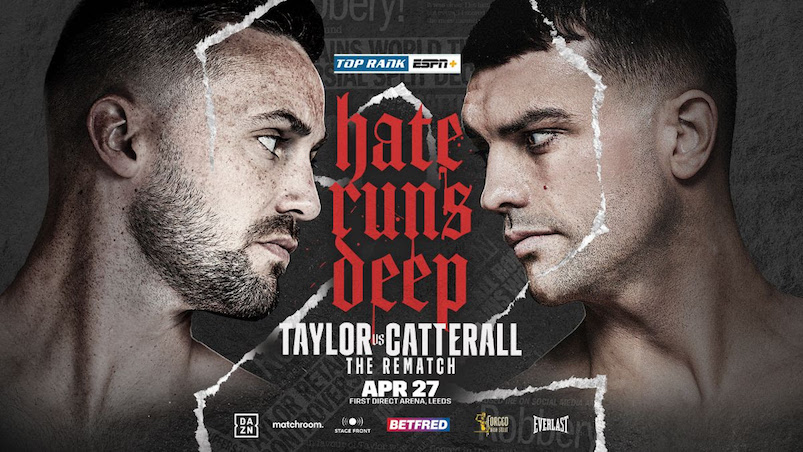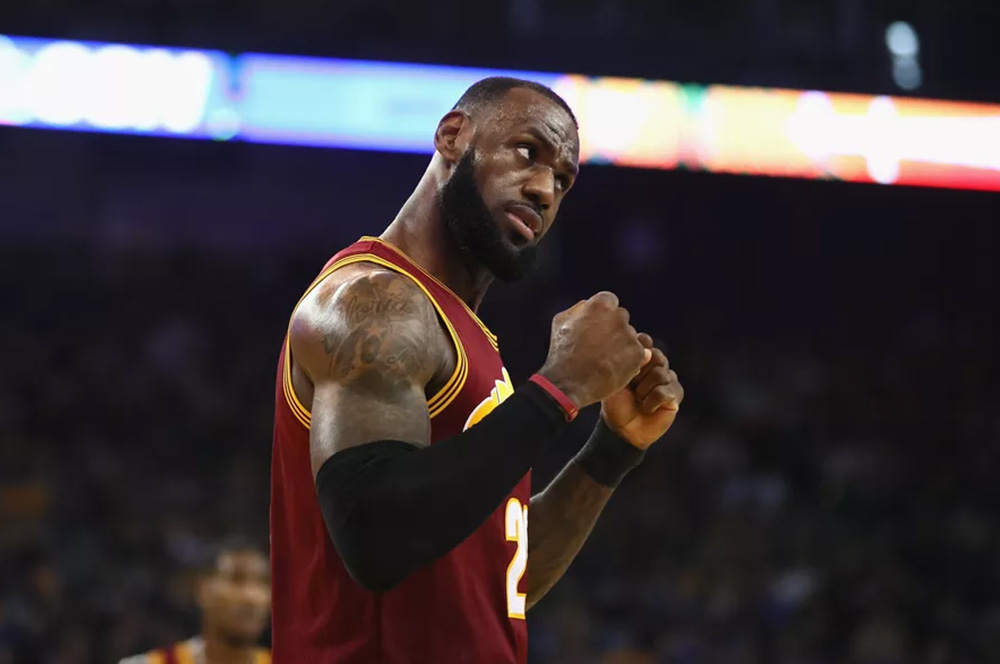The answer will reveal everything about the Cavaliers’ strategy.
If you’re seeking a strategic -- as opposed to a karmic — reason for the Cavaliers’ improbable comeback victory in the 2016 NBA Finals, look no further than LeBron James’ primary defensive assignment.
For the first two games, James hid on Harrison Barnes or another non-threatening Warrior, only to see his teammates fall asleep against the Warriors’ cute off-ball movement. From Game 3 on, James began possessions guarding Draymond Green, allowing LeBron to switch the Green/Stephen Curry two-man actions that buoyed the Warriors’ offense. Cleveland won four of the next five games to win the title.
OK, so a few other consequential things also happened. Still, that strategic shift by Tyronn Lue is an underplayed element when telling the story of the Warriors blowing a 3-1 lead.
Putting LeBron on Draymond meant the Cavaliers slid Tristan Thompson to Harrison Barnes and Kevin Love to the fifth Warrior (usually Andre Iguodala, but also whoever played center when the Warriors used more traditional lineups).
Barnes and Iguodala couldn’t make the Cavaliers pay, either in isolation situations or with off-ball movement. Thus, the Cavaliers survived those mismatches. Replacing Barnes with Kevin Durant, the best bucket-getter in the NBA, makes it a whooooole looooottttt harder for the Cavaliers.
In addition, the Cavaliers have been employing a different defensive strategy this postseason. They have aggressively double-teamed other stars to take the ball out of their hands and used James as a roamer off non-threats to cover up those gaps.
1. Match up traditionally: LeBron on KD
This is the answer that requires the fewest trade-offs. James is the only appropriate size matchup for Durant on the Cavaliers’ roster; everyone else is either too small or too slow. This also allows the Cavaliers to hide Love on the Warriors’ fifth player, making it easier to keep him on the floor.
That’d leave Tristan Thompson to check Draymond and Kyrie Irving to trade guard assignments depending on which of Cleveland’s three shooting guards (J.R. Smith, Iman Shumpert, Kyle Korver) plays alongside him.
Is this best, though? It depends whether the Cavaliers believe that stopping Durant is the ultimate key to stopping the Warriors.
Put James on Durant, and in theory those go away. Maybe the other Cavaliers can contain the other Warriors with renewed effort, switching, and focus. Maybe.
Golden State could still try to force the mismatch by having Durant screen for whoever Irving’s guarding (probably Curry), but that’s not really in their DNA. If the Warriors want to seek the mouse in the house, that means Cleveland sees less of their beautiful off-ball movement. The Cavs will count that as a win.
Curry and Durant also have awkward screening chemistry, though it has improved since January. This isn’t like the Irving/LeBron two-man game that Zach Lowe celebrated here. Can they even force Cleveland to switch when the chips are down? Maybe, maybe not.
On the other hand, Durant’s ability to score on his own cuts both ways. Because he is such a good solo artist he can get his buckets against anyone. If that’s the case, why waste the most important defender on him? The Cavaliers could decide that Durant will get his points anyway, so better to focus on shutting down the other four Warriors.
Throwing James on Durant also allows the Warriors to use Durant as a decoy to takes James out of plays. Watch James on this Curry/Pachulia pick-and-roll from the teams’ Christmas Day matchup.
The Warriors know that Cleveland won’t want Love to switch onto Curry, so they expect the trap. To pull this off properly, the other three Cavaliers need to zone up off the other four Warriors to fill the gaps. James, of course, is the Cavalier best at flying in from the opposite side to plug a hole.
Because he’s on Durant, he thought twice about going anywhere. He didn’t want Curry to swing a pass crosscourt for Durant to hit an open three, so he paid Durant more respect than he would another small forward.
That means that Pachulia got a clean catch diving down the hoop, which ultimately created a Klay Thompson layup. James, the most fearsome help defender in basketball, was one step slow to rotate to Pachulia because of KD’s threat.
If James is on someone else, he’s a step closer and can meet Pachulia at the rim on that play. The question is, who else?
2. Keep LeBron on Draymond anyway
Lue may ultimately decide that not enough has changed to alter Cleveland’s fundamental approach. Even with Durant around, one could argue that Green’s versatility is the key to the Warriors’ chaotic attack. He handles the ball, screens best with Curry, and orchestrates much of the Warriors’ flow.
You could see the Cavaliers talking themselves into a version of last year’s strategy working again. Cleveland would switch all Green/Curry two-man actions, putting James on Curry and hiding a smaller man on a player that can post up mismatches, but isn’t nearly as scary as Durant or even Klay.
An added positive is that James could roam off Green when he isn’t involved in the play. Green shot just 31 percent on threes during the regular season, so Cleveland could make him beat them from the outside the same way they did to more proficient regular-season shooters like Jae Crowder and P.J. Tucker.
But Green is nailing 47 percent of his triples in the playoffs. If he continues to make shots at that rate, the roaming strategy will fail.
Plus, there’s the larger problem discussed earlier: Tristan Thompson covering Kevin Durant. That will be a challenge in isolation situations, but it’ll be even harder in transition and when Durant moves without the ball.
The trade-offs may simply outweigh the positives this time. Green is less pivotal to the Warriors’ offense than last year, and Durant can punish Thompson in a way Barnes never could. The Cavaliers would be forced to play only one of Love and Thompson to get an extra perimeter defender on the floor to cover Durant, and that’s not ideal.
3. Go outside the box: LeBron on Klay Thompson
This was actually Cleveland’s option of choice during major stretches of the teams’ two regular-season matchups. James was tasked with chasing Thompson around, leaving a different wing player to guard Durant.
One important caveat: J.R. Smith was injured for both regular-season games, which forced the Cavaliers to often play Richard Jefferson at shooting guard. Jefferson handled the Durant assignment, which makes sense because he has more size than Smith.
Would Lue go back to LeBron on Klay if the trade-off was sticking Smith on Durant instead of Jefferson or Shumpert? And is this possible if Korver — who was in Atlanta when these teams played on Christmas and had just arrived by the MLK Day rematch — is on the court instead of Smith? Probably not, but here’s the counterargument:
If James is on Thompson instead of Durant, he’s at least not guarding the ball as often. It’s dangerous as hell to leave Thompson to roam, but at least James will be in a position to do so if necessary more often than he would guarding Durant.
James is also in a better position to address the Warriors’ baseline screening action if he’s on Thompson. The Warriors like to use the threat of Thompson’s shooting to spring Curry or Durant open. By starting on Thompson, James is in position to switch in both of those cases. If that leaves a poor defender on Thompson, at least it’s better for Cleveland than leaving that same poor defender on Durant.
But even so, the decoy dilemma we spoke of with LeBron checking Durant applies double to Klay. What’s to stop the Warriors from stationing Thompson in the corner and pulling the Cavaliers’ best defender into his vortex?
That’s actually what they did in the 2015 Finals to combat Cleveland’s traps on Curry. David Blatt thought he was being clever by asking Smith and Shumpert to face-guard Thompson, but it actually played into the Warriors’ hands. It turned the 4-on-3 situations Green dominated once Curry gave the ball up on a trap into 3-on-2s.
4. Go REALLY outside the box: start LeBron on Stephen Curry
Hey, don’t rule it out. Six years ago, LeBron shut down MVP Derrick Rose one-on-one down the stretch of Eastern Conference Finals games. Maybe he’ll do the same for Curry? If James is on Curry, then you figure he’ll switch every pick and roll, since he can cover any Warrior.
But this seems too bold even for the Cavaliers. You still have the pesky dilemma of Durant against a mismatch, and now Irving has to guard Klay. That did not go so well in the Christmas Day game.
5. Go REALLY REALLY outside the box: LeBron stays the roamer
In other words: stay the course with the new “secret” defense unveiled for the playoffs. Put James on the worst Warrior, whether it’s Zaza Pachulia, JaVale McGee, Andre Iguodala, or whoever else. Then, have James “guard” them while really playing free safety to help on the four Warriors that actually matter.
There are obvious downsides to this approach. It forces a trio of mismatches: Love must now defend Draymond (or sit on the bench), Tristan Thompson has to check Durant, and Irving has to stay with one of the Splash Brothers.
So what’s the right answer?
In truth? All of the above.
LeBron will play a different defensive role when he shares the court with Cleveland’s bench than when he plays with the starters. He’ll also switch it up depending on how many of the four core Warriors are on the court at the same time. We will certainly see three of these options at different points, and might see four, or even all five, as the series progresses.
No matter how James is deployed to start Warrior possessions, this decision has important ripple effects for Cleveland’s defensive strategy. It determines the other matchups, lays out different guidelines for mid-possession Cavaliers switches, and reveals the trade-offs Cleveland is willing to accept to get the defensive job done.
The Cavaliers cannot possibly stop every prong of the Warriors’ attack, but they can use James to stamp out what they believe to be the root of its success.
Is it Durant’s bucket-getting? Is it Green’s versatility? Is it the threat of Thompson’s shooting? Is it Curry, the head of the snake? Is it the openings created by the combination of spacing and movement that puts normal off-ball defenders in a pickle?
You’ll know the Cavaliers’ belief based on James’ primary assignment.
This is an incredibly difficult choice for the Cavaliers. It’s possible — perhaps even likely — that none of them work. But at least they have a player like LeBron that makes all these options possible.



